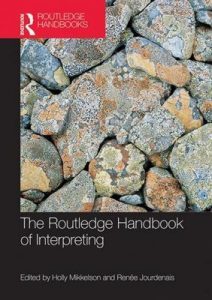
02 Jun The Routledge Handbook of Interpreting: A Multifaceted Resource
This post was originally published on The Savvy Newcomer on August 2, 2016. Republished with permission from the author, Helen Eby, NAJIT Member and one of the leaders of our 2017 Advocacy Day efforts.
By Helen Eby ©2016
One of my resources is The Routledge Handbook of Interpreting, edited by Holly Mikkelson and Renée Jourdenais. Its twenty-seven chapters cover a remarkably broad spectrum of topics relating to interpreting, with the following sections: historical perspectives, modes of interpreting, interpreting settings, and issues and debates. Each chapter is written by an expert in the field, sometimes two, each of whom has devoted careful research to the work.
For this review, I chose the chapters which I had seen discussed objectively the least in other settings. The book is meant to be read one chapter here or there, as a reference book. The chapters I referenced for this review focus on non-professional interpreters and quality.
In the professional listservs I participate in, members discuss issues that affect our profession. The issues of non-professional interpreters and quality are discussed there, but the participants often only give one side of the story. The discussion in these chapters, however, provided a fresh, unbiased look at these issues.
Chapter 26: Non-professional interpreters
As interpreters, we believe that some uses of non-professional interpreters put patients at risk. Situations like the following, from my professional experience, come to mind:
A young mother came to a medical appointment with her seven-year-old son ready to fill in as interpreter because his baby brother had a broken elbow. He had interpreted before. He was visibly relieved to be able to be a little boy and make paper airplanes with blank pages from my notepad. The adult daughter of another patient almost didn’t allow me to interpret for her father at a dialysis appointment. I had to reassure her that I was properly certified and would allow her to correct me as needed. She enjoyed her role as a daughter for the first time in many appointments.
When people depend on untrained interpreters for high-stakes appointments, there can be significant negative consequences. Logistically, professional interpreters simply cannot be everywhere at all times. Because of that, many of us started as non-professional interpreters before we became professionals, providing important services to our communities. For example, from 1986 to 1988 I interpreted for customs and immigrations officers, as well as in church settings, in almost all countries in Latin America. That was before I was ever trained.
In the section on non-professional interpreters, Aída Martínez-Gómez acknowledges this fact. Non-professional interpreters are, she says, “individuals with a certain degree of bilingual competence who perform interpreting tasks on an ad hoc basis without economic compensation or prior specific training” (Martínez-Gómez 2007, em. original). Interpreting started as a non-professional endeavor, and she brings this to light.
An honest, unbiased discussion of this issue is refreshing. This chapter does not advocate for non-professionals to be assigned responsibilities in areas of high risk, but simply acknowledges that we simply wouldn’t be able to get along without them. As a matter of fact, most of my interpreting students got their start by interpreting for friends and neighbors before they decided they wanted to take a class to learn how to do it “the right way.” Those interpreters are often very well prepared to learn how to be professionals, and are highly dedicated to excellence!
Chapter 23: Quality
In their discussion of quality, Ángela Collados Aís and Olalla García Becerra argue that there are so many ways to evaluate quality that it is very difficult to come to a consensus. Most measures of quality are dependent on what interpreting ethics are applied to the situation. The court setting is adversarial and highly scripted, as well as being recorded, so all court interpreting codes of ethics emphasize accuracy and impartiality, because what the interpreter says in English is the record. The medical setting is cooperative, so the National Council on Interpreting in Health Care (NCIHC) Code of Ethics includes advocacy, while accuracy is still extremely important.
While there is an ideal level of quality to which all interpreters should aspire, Collados Aís and García Becerra explain that there are factors preventing this level from being reached. We need to understand that. Quoting another study (Collados Aís et al. 2007, 215), they propose a categorization of quality, “establishing four blocks of priorities in expectations:
Block 1: sense consistency and cohesion
Block 2: completeness, terminology and fluency
Block 3: diction, style and grammatical usage
Block 4: intonation, voice and accent
“In other words, subjects attribute more a priori importance to factors related to content and message fidelity than those related to form.” (Collados Aís and García Becerra 2007, em. original)
Some barriers to quality are related to poor advance planning, such as not knowing what the appointment is about, not knowing how long it will last, or being in an environment in which the interpreter can’t see or hear clearly. Quality can’t be achieved unless interpreters know what is expected of them before the appointment. Unfortunately, this is often neglected.
In Summary
I reviewed these two chapters because they stood out to me with their fresh look at critical issues. If you read the book yourselves, you will find much more information. Additionally, at the end of each chapter, there is a list of suggested reading and a substantial bibliography.
I carry the book on my Kindle and don’t expect to read it cover to cover. Then again, who knows? It is an excellent reference any time I have a question about an interpreting topic.
Thank you, Holly and Renée, for your excellent work putting this together! We, the interpreters, trainers, and policy makers of the interpreting world can’t thank you enough! Everyone should have this book on their shelf, in their Kindle, or somewhere.
References
Aída Martínez-Gómez. 2007. “Non-professional Interpreters.” In Mikkelson and Jourdenais, The Routledge Handbook of Interpreting, chap. 26.
Collados Aís, Ángela, E. Macarena Pradas Macías, Elisabeth Stévaux, and Olalla García Becerra (eds). 2007. Evaluación de la calidad en interpretación simultánea: parámetros de incidencia. Granada: Comares. (Qtd. in Collados Aís and García Becerra 2007, “Quality”.)
Collados Aís, Ángela and Olalla García Becerra. 2007. “Quality.” In Mikkelson and Jourdenais, The Routledge Handbook of Interpreting, chap. 23.
Mikkelson, Holly and Renée Jourdenais (eds). 2007. The Routledge Handbook of Interpreting. New York, NY: Routledge. Kindle edition.
 Helen Eby has been working in translation and interpreting since 1984. She has been participating actively in the ATA in different roles for quite a few years, helping with the Spanish Division, the Business Practices Education Committee, and the Interpreting Division. She is also involved in the ASTM Standards for Translation. Of course, she keeps it real by keeping it local, working with her local association in Oregon!
Helen Eby has been working in translation and interpreting since 1984. She has been participating actively in the ATA in different roles for quite a few years, helping with the Spanish Division, the Business Practices Education Committee, and the Interpreting Division. She is also involved in the ASTM Standards for Translation. Of course, she keeps it real by keeping it local, working with her local association in Oregon!
As the team leader of The Savvy Newcomer, Helen listens carefully to everyone’s voice and trusts each team member to do the work once a task has been delegated. She also reaches out to potential authors to involve them in the work of The Savvy Newcomer.
In 2012, Helen Eby advocated for a raise in the rates for court interpreters in Oregon, which resulted in the first raise for court interpreters in over 15 years. As a founding member of the Oregon Society of Translators and Interpreters and first President, she helped draft a document to deliver to her representatives in DC. She has also been involved in negotiating changes to the laws and regulations regarding medical interpreting in Oregon. In 2015, she co-authored a document with descriptions of interpreters and translators work that has been endorsed by eleven professional associations.

One thought on “The Routledge Handbook of Interpreting: A Multifaceted Resource”